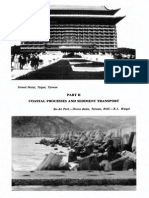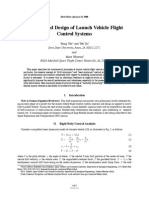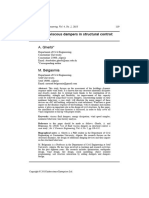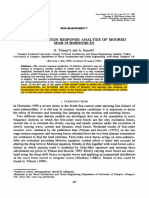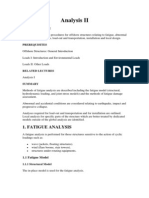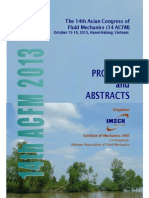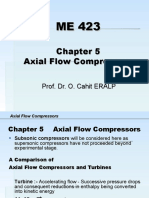Jcam 2013
Jcam 2013
Uploaded by
ebrahem_sahil5188Copyright:
Available Formats
Jcam 2013
Jcam 2013
Uploaded by
ebrahem_sahil5188Original Title
Copyright
Available Formats
Share this document
Did you find this document useful?
Is this content inappropriate?
Copyright:
Available Formats
Jcam 2013
Jcam 2013
Uploaded by
ebrahem_sahil5188Copyright:
Available Formats
Journal of Computational and Applied Mathematics 246 (2013) 153160
Contents lists available at SciVerse ScienceDirect
Journal of Computational and Applied
Mathematics
journal homepage: www.elsevier.com/locate/cam
The transient temporal response of a flexible bridge deck subjected to a
single gust
X. Amandolese a,b, , P. Hmon b , S. Manzoor b
a
Dpartement ISME, CNAM, Paris, France
LadHyX, Ecole Polytechnique-CNRS, Palaiseau, France
article
info
Article history:
Received 30 January 2012
Received in revised form 12 July 2012
Keywords:
Bridge deck
Wind effect
Transient response
Time-dependent simulations
abstract
Temporal simulations are increasingly performed in wind effects analysis of flexible
structures. By comparison with classical techniques such as spectral methods, temporal
simulations provide the advantage of easily combining different kinds of loads, can take
nonlinearities into account and also provide the only way to reproduce transient behaviors.
In that context this study deals with the transient response of a two-degrees-of-freedom
streamlined bridge deck section subjected to a single gust. Experimental evidence of the
potentially high level of transient energy amplification due to that kind of extraneous
excitation have been recently demonstrated for an airfoil section and for a streamlined
bridge deck section, below the critical coupled-mode flutter wind speed. The present
study then focuses on the validation of a time-dependent model, based on a simple
formulation of both the motion-dependent and the buffeting forces, for catching that kind
of transient behavior. A parametric study is also made in order to highlight the impact of
the pitchplunge frequency ratio on the energy amplification below the critical condition.
2012 Elsevier B.V. All rights reserved.
1. Introduction
Wind-induced responses of flexible structures encountered in civil engineering are traditionally studied using frequency
domain approaches. Based on linear formulations of motion-dependent and buffeting loadings, spectral methods are
generally sufficient for catching the critical parameters for the onset of flutter or calculating the variance associated with
the dynamical response to a stationary turbulent wind [1,2].
Meanwhile, time domain analysis of wind effects on structures has been increasingly performed in recent years. By
comparison with spectral methods, temporal simulations provide the advantage of easily combining different kinds of loads,
can take structural and/or aerodynamic nonlinearities into account and also provide the only way to reproduce transient
behaviors. A time domain approach has been successfully used in [3] for the analysis of flutter and buffeting responses of
bridges. Effects of turbulence and aerodynamic nonlinearity have been pointed out in [4]. More recently, Costa et al. [5]
proposed a windbridge interaction study using a time domain approach.
In the present paper we focus on a new type of short-term instability that has been recently highlighted in the
field of fluid-structure interactions: the transient growth response to an initial perturbation before coupled-mode flutter.
Theoretically studied in [6], this short-term energy growth can lead to substantial amplitude motion, even in a stable
dynamical system, due to the non-orthogonal modes involved in the system. It is strongly dependent on the initial
conditions.
Correspondence to: LadHyX, CNRS-Ecole Polytechnique, F-91128 Palaiseau, France. Tel.: +33 1 69 33 52 86; fax: +33 1 69 33 52 92.
E-mail addresses: xavier.amandolese@ladhyx.polytechnique.fr (X. Amandolese), pascal.hemon@ladhyx.polytechnique.fr (P. Hmon),
sherry.manzoor@gmail.com (S. Manzoor).
0377-0427/$ see front matter 2012 Elsevier B.V. All rights reserved.
doi:10.1016/j.cam.2012.07.027
154
X. Amandolese et al. / Journal of Computational and Applied Mathematics 246 (2013) 153160
Table 1
Structural parameters of the two different bridge deck sections studied.
fz /f
Case A
Case B
0.62
0.44
f (Hz)
fz (Hz)
7.12
8.00
4.43
3.56
k (N m/rad)
1.33
1.67
kz (N/m)
JO (kg m2 )
m (kg)
(%)
z (%)
519.36
309.16
6.64 e
6.61 e4
0.66
0.62
0.3
0.24
0.08
0.07
Experimental evidence of transient growth of the energy before coupled-mode flutter has been recently demonstrated
for an airfoil section in [7] and a streamlined bridge deck section [8,9] subjected to mechanical or gust perturbation. Those
results have shown that short-term energy amplification of the initial energy can reach a factor of more than 5 and can even
trigger flutter instability in the case of nonlinear structures [10].
In that context, the present study deals with the transient response of a two-degrees-of-freedom bridge deck section
subjected to a single gust. A rigid bridge deck section is flexibly mounted in heave and pitch in a steady air flow. The velocity
is maintained under the critical condition, i.e. below the coupled-mode flutter critical wind speed. A superimposed single
gust produces an initial excitation. The experimental setup and parameters are first detailed. Then a time-dependent model,
based on a simple formulation of both the motion-dependent and the buffeting forces is presented. Computed results are
compared with the experimental results. Finally, a numerical parametric study is done in order to highlight the impact of
the pitchplunge frequency ratio on the energy amplification below the critical flutter wind speed.
2. Transient wind tunnel tests
2.1. The experimental setup and identification of parameters
The main points of the experimental setup are recalled here. Further details concerning the experimental procedure can
be found in previous work [8,9]. The bridge deck section is flexibly mounted in heave and pitch in a closed wind tunnel
with the setup shown in Fig. 1. The two degrees of freedom z (t ) and (t ) are measured using laser displacement sensors
connected to an acquisition system.
The elastic center of the deck section model is located at its gravity center, i.e. the mid-chord. The equations of motion
for this structurally non-coupled two-degrees-of-freedom system can then be expressed as follows [11]:
mz + 2mz z z + kz z = Fz ,
(1)
JO + 2JO + k = MO .
Assuming that the structural damping is small, the eigenvalues can be written in the form
= 2 = (2 f )2 = k /JO ;
z = z2 = (2 fz )2 = kz /m.
(2)
Structural parameters are identified for each degree of freedom under zero wind velocity. Both the natural frequencies fz
and f are obtained by spectral analysis. A static weight calibration technique is used to assess the stiffnesses kz and k . The
inertia JO and mass m are then deduced, using
m = kz /z ;
JO = k / .
(3)
Pure structural damping values z and are determined using a standard decrement technique in free-decay tests under
the zero-wind condition.
In the present study two different cases characterized by two different frequency ratios fz /f between the heaving and
pitching motions are tested. The structural parameters are summarized in Table 1.
The gust is produced by a flap mounted upstream from the test section. It is pre-tensioned with a spring and suddenly
released. A typical time history of the perturbation of the flow velocity is plotted in Fig. 2, where U is the mean velocity, u(t )
and w(t ) being the longitudinal and vertical perturbations respectively. The flap generates a transient short impulse in the
wind velocity, leading to a unique peak in the longitudinal component u, and two opposite peaks in the vertical component
w. The time duration of this perturbation is about 0.05 s, which is three times below the typical period of the system.
2.2. Transient results
Because of the aerodynamic loading, a two-degrees-of-freedom bridge deck section can experience coupled-mode flutter
instability above a critical velocity Uc . For both Case A and Case B the critical wind speed has been experimentally measured,
at respectively 16.1 and 21.3 m/s. The responses of both the section model subjected to mechanical excitation (a sudden
release of an initial pitch angle) or gust excitation (produced by the upwind flap) are then studied for different mean
velocities below the critical condition.
For each test, the mechanical energy of the system, defined as the sum of the kinetic energy and the potential energy, is
computed from the measurements of z and such that
E (t ) =
1
2
mz 2 (t ) +
1
2
JO 2 (t ) +
1
2
kz z 2 (t ) +
1
2
k 2 (t ).
(4)
X. Amandolese et al. / Journal of Computational and Applied Mathematics 246 (2013) 153160
155
Fig. 1. Bridge deck cross section and experimental setup schematics, with dimensions in mm.
1.6
0.2
1.4
0.1
1.2
0.8
0.025
0.05
0.075
0.1
Time (s)
0.025
0.05
0.075
0.1
Time (s)
Fig. 2. Sample of upstream velocity perturbation measured with a 2D hot wires probe.
4
3
2
1
5
0
3
0
Time (s)
Fig. 3. Typical transient response of the deck to a gust excitation, U /Uc = 0.91; Case A.
A typical result of the transient response is given in Fig. 3 for the Case A subjected to gust excitation. Before the critical
condition, the dynamical response is characterized by initial amplification of energy followed by a monotonic decay due
to the asymptotic stability of the system. In Fig. 3, the mechanical energy is normalized using E0 , the initial energy of the
system. For initial mechanical excitation, E0 is simply computed as the potential energy that is produced by the imposed
initial pitch angle. For gust excitation, the initial energy E0 transmitted to the system can be measured at the distinct local
peak on the total energy response occurring before the transient growth amplification due to the dynamics of the system.
This gust signature which can be viewed as the gust energy that is immediately transmitted to the deck is clearly noticeable
in Fig. 3 at a time close to 2.9 s. One can also notice that this local peak occurs when the deck reaches approximately the
first minimum in the plunge, while it reaches approximately the maximum velocity in the pitch. Experimental values of this
initial energy E0 are reported in Fig. 4 for both Case A and Case B and various wind velocities. These results show that the
evolution of E0 overlaps in the common velocity region between Case A and Case B, indicating that this reference energy of
the gust impulse is independent of the structure. More details about the experimental procedure for the evaluation of E0
can be found in [9].
156
X. Amandolese et al. / Journal of Computational and Applied Mathematics 246 (2013) 153160
Fig. 4. Initial energy transmitted by the gust versus velocity. Case A: ; Case B: N.
3. Numerical simulations with time-dependent models
3.1. Time-dependent models
Assuming the validity of linear superposition, the time-dependent model is expressed as the sum of motion-dependent
(m) and buffeting (b) loads:
Fz (t ) = Fzm (t ) + Fzb (t )
(5)
MO (t ) = MOm (t ) + MOb (t ).
(6)
The motion-dependent sectional forces, per unit span, can be expressed as
1
Fzm (t ) =
MOm
B(
t)
z (t )
z (t )
+ H2
+ H3 (t ) + H4
BU 2 H1
(t ) =
(7)
z (t )
B(
t)
z (t )
2
B U A1
+ A2
+ A3 (t ) + A4
.
2
(8)
B
U
U
This motion-dependent linear formulation, originally proposed in [12] for a bridge deck undergoing small amplitude
harmonic motions, introduces B, the deck section length, , the air density, U, the mean velocity, and flutter derivative
coefficients Hi and Ai , which depend on the reduced angular frequency K = 2 fB/U.
The flutter derivatives are written using the unsteady airfoil theory [11] adapted to the case of a bridge deck which has
its rotation center and its gravity center both located at mid-chord [13]:
2
H1 = Cz F ,
H2 = Cz
A1 = CM F ,
F
4
A2 = CM
F
4
+
+
K
G
K
Cz
4
Cz
16
KG
H3 = Cz F
,
4
,
,
A3 = CM F
KG
4
H4 = Cz KG +
+ Cz
K2
128
K2
4
A4 = CM
KG.
(9)
(10)
F and G which also depend on K are respectively the real and imaginary parts of Theodorsens function [14]. Those
expressions also introduce the static lift slope Cz and pitching moment slope CM
of the deck section at small angles of attack.
Both have been experimentally identified in wind tunnels in the appropriate Reynolds number range. With Cz 5.65 and
CM
1.8 the aerodynamic center of the deck section is found to be at 32% of the chord.
A transient formulation based on Kssners function is used for the buffeting terms [11]:
Fzb (t ) =
MOb (t ) =
BU 2 Cz ( )
(11)
2
1
B2 U 2 CM ( )
(12)
2
/B is calculated using Duhamels integral such that
where the transient function of the non-dimensional time = 2 Ut
w ( )
+
U
w ( )
( ) d
U
(13)
( ) = 1 0.5 exp (0.13 ) 0.5 exp ( ) .
(14)
( ) = (0)
X. Amandolese et al. / Journal of Computational and Applied Mathematics 246 (2013) 153160
157
Fig. 5. Evolution of frequencies versus wind velocity. Case B, Uc = 21.5 m/s.
The gust vertical component w(t ) is fitted from the experiments with two Gaussian distribution functions, with wmin , wmax
and the time scale of the gust as parameters. Kssners function is approximated with the expression of Jones [11] for
an elliptic airfoil. In this model the effect of the longitudinal component of the gust u(t ) is neglected. Indeed it induces an
additional term proportional to the mean lift coefficient (or pitching moment) at zero angle of attack, which is relatively
small.
In the next section, computed solutions will be compared to experimental results using two alternative versions of the
time-dependent formulation of the motion-dependent forces. In the first one, named TDM-1, the full model expressed in
Eqs. (7)(8) will be used. The second one is a simplified version, named TDM-2, which neglects aerodynamic damping:
coefficients H1 , H2 , A1 and A2 are then set to zero.
Temporal simulations of the problem are performed with a Newmark algorithm which has no numerical damping that
could corrupt the solution. Computed time histories of z and are then processed for calculating the total mechanical energy
following Eq. (4) as in the experimental procedure.
3.2. Results and comparison with experiments
Due to the aerodynamic forces, the frequency of both the modes of the system might be dependent on the wind velocity.
For a bridge deck section characterized by an aerodynamic center located among the elastic centers and a frequency ratio
fz /f less than 1, a coupled-mode flutter involving a frequency merging can occur. The frequency evolution of the two modes
versus the wind velocity has been experimentally measured using Fourier analysis of the heaving and pitching response of
the system undergoing free-decay tests. Results obtained for Case B are compared in Fig. 5 with computations using full
(TDM-1) and no-damping (TDM-2) time-dependent formulations of the motion-dependent forces.
At low velocities, both models give a good evolution of the system dynamics with a decrease of the pitching frequency,
while the heaving one remains almost constant. However when the velocity approaches the critical flutter velocity, the
model neglecting the aerodynamic damping fails to predict the sudden merging of frequencies due to a sharp increase of
the heaving mode. On the other hand, the full aeroelastic model TDM-1 fits the experimental results very well and predicts
a critical velocity in accordance with the experiments. It is well known that damping terms can exert a substantial effect on
the long-term stability of a dynamical system. In that context those results clearly demonstrate that, for the prediction of
the onset of coupled-mode flutter, a full model of the aeroelastic effects is indispensable.
Using the two motion-dependent models alternatively, computed responses to initial mechanical excitation are now
compared against the experiments. The test procedure used is as follows: for a wind velocity under the critical condition
a negative pitch angle 0 = 2.2 is imposed and the deck is suddenly released. Experimental and computed maximum
energy amplifications are plotted in Fig. 6 versus the wind velocity ratio U /Uc . The model that catches the dynamics of this
short-time instability is now TDM-2, which neglects aerodynamic damping. Indeed the full TDM-1 model underpredicts the
energy amplification while the TDM-2 model fits very well with the experiments.
Motion-dependent models are now used to predict the transient behavior due to a single gust excitation, buffeting loads
induced by the gust being introduced in our time-dependent formulation using Eqs. (11)(14). Examples of the time histories
of the energy, pitch angle and heaving position are shown in Fig. 7. One can clearly observe that the full model TDM-1 still
fails to reproduce the transient dynamics of the system. Looking at the long-time dynamical response of the system one can
notice that this full aeroelastic model follows the energy profile but overdamped it, as for the response in both the heaving
and pitching motions. This demonstrates that the aerodynamic damping terms based on Theodorsens airfoil formulation
are overestimated. Among the four aerodynamic damping terms, the pure terms H1 and A2 are those which most strongly
affect the damping in heave and pitch. They can be used to calculate added aerodynamic damping coefficients that can be
158
X. Amandolese et al. / Journal of Computational and Applied Mathematics 246 (2013) 153160
Fig. 6. Maximum energy amplification versus velocity ratio. Mechanical excitation 0 = 2.2. Case A: left; Case B: right.
Fig. 7. Time evolution of the energy, angular displacement and vertical displacement. Excitation by gust, U /Uc = 0.96; Case B.
compared to the pure structural damping of the system using the following expressions:
zae =
1
4mz
UBH1
ae =
1
4JO
UB3 A2 .
(15)
Using the flutter derivative formulation expressed in Eqs. (9) and (10) one finds, close to the critical velocity, zae 2.5% and
ae 10%. Those values, forty times higher that the pure structural damping coefficients z and , explain the strong effect
of the aerodynamic damping terms, between the short-term and long-term behaviors. But while an inaccurate evaluation
of those aerodynamic damping coefficients seems to have an insignificant effect on the frequency evolution of the system,
as with TDM-1, this is not the case for the transient growth behavior. Indeed, as shown in Fig. 7, the early-time dynamics
due to the transient growth of the energy is well simulated by the simple model TDM-2, leading to a correct evaluation of
the maximum energy amplification, while TDM-1 overdamps the response.
These results demonstrate that the motion-induced flow mechanisms generating aerodynamic damping are either not
effective or have an insignificant effect on the transient regime. On the other hand the TDM-2 model overestimates the
long-time dynamical response. In that context and in order to accurately predict the long-time dynamics of the system, a
better evaluation of the flow-induced damping terms seems then necessary. A bridge deck section, even streamlined, has
a negative mean lift force which is induced by a flow which is indeed different from the one around a zero-lift thin airfoil
which is used in Theodorsen theory.
In the present paper we are mainly focused on the transient behavior of the system, seeking the simplest model capable of
reproducing the physics. The efficiency of the TDM-2 model for predicting the short-time amplification due to the transient
growth of the energy is confirmed in Fig. 8, which presents the experimental and computed maximum energy amplification
versus wind velocity ratio for Case A and Case B.
X. Amandolese et al. / Journal of Computational and Applied Mathematics 246 (2013) 153160
159
Fig. 8. Maximum energy amplification versus velocity ratio; excitation by gust. Case A: left; Case B: right.
Fig. 9. Effect of the frequency ratio on the maximum energy amplification versus velocity ratio.
Fig. 10. Influence of the frequency ratio on the maximum energy amplification at critical velocity.
3.3. A numerical study of the impact of the frequency ratio
In this section a short parametric study is performed to highlight the impact of the frequency ratio between heaving and
pitching modes fz /f . With Case B as a reference, three other ratios have been built, changing the structural stiffness and
thus the heaving natural frequency only. For all those frequency ratios the coupled-mode flutter velocity is first computed
using the full motion-dependent model (TDM-1) validated in Section 3.2. The numerical model TDM-2, which provides the
best results in the transient regime, is then used to study the transient response to a single gust excitation.
The maximum energy amplification versus velocity ratio is given in Fig. 9 for fz /f = 0.33, 0.44 (Case B), 0.62 ( Case
A) and 0.75. The associated critical velocities are Uc = 22.6, 21.5, 18.65 and 15.6 m/s respectively. It is then interesting to
notice that the lower frequency ratio, which is a priori the most secure one in terms of coupled-mode flutter sensitivity,
leads to the highest amplification of energy. This trend is shown more clearly in Fig. 10 where the maximum energy
amplification just below the critical velocity, denoted as (Emax /E0 )c , is plotted versus the frequency ratio. On the other hand
one cannot ignore the fact that the critical velocity decreases with the frequency ratio and, as reported in Fig. 4, the initial
energy E0 transmitted by the gust also increases with the velocity. In that context, as seen in Fig. 11, whatever the frequency
ratio, the maximum energy which is reached during the transient response remains almost the same for a given velocity U.
160
X. Amandolese et al. / Journal of Computational and Applied Mathematics 246 (2013) 153160
5,E-02
4,E-02
3,E-02
0.33
0.44
0.62
0.75
2,E-02
1,E-02
0,E+00
Fig. 11. Effect of the frequency ratio on the maximum energy versus the velocity.
4. Conclusions
Wind tunnel experiments have shown that a two-degrees-of-freedom bridge deck section subjected to a single gust can
exhibit transient growth of energy before the coupled-mode flutter condition. Time-dependent models based on classical
formulations of both the motion-dependent and the buffeting forces have been tried to reproduce this transient behavior.
The buffeting term, expressed in terms of a convolution integral using a Kssner function based indicial function has been
successfully used to compute the gust excitation.
For transient response analysis, numerical results were found to be in good agreement with the experiments using a
motion-dependent formulation of the aerodynamic forces neglecting the aerodynamic damping terms. On the other hand,
a full aeroelastic model remains indispensable for correctly evaluating the coupled-mode flutter critical velocity.
A short numerical parametric study has been made in order to highlight the impact of the pitchplunge frequency ratio
on the energy amplification below the critical flutter wind speed. Although the lower frequency ratio leads to the highest
amplification of energy, before the critical conditions, the maximum energy which is reached during the transient response
was found to remain quasi-constant for a given mean velocity U.
References
[1]
[2]
[3]
[4]
[5]
[6]
[7]
[8]
[9]
[10]
[11]
[12]
[13]
[14]
A.G. Davenport, Buffeting of a suspension bridge by stormy winds, J. Struct. Div., ASCE 88 (3) (1962) 233268.
R.H. Scanlan, The action of flexible bridges under wind. 2: Buffeting theory, J. Sound Vib. 60 (2) (1978) 201211.
X. Chen, M. Matsumoto, A. Kareem, Time domain flutter and buffeting response analysis of bridges, J. Eng. Mech., ASCE 126 (1) (2007) 716.
X. Chen, A. Kareem, Aeroelastic analysis of bridges: effects of turbulence and aerodynamic nonlinearities, J. Eng. Mech. 129 (8) (2003).
C. Costa, C. Borri, O. Flamand, G. Grillaud, Time domain simulations for windbridge interactions, J. Wind Eng. Ind. Aerodyn. 95 (2007) 9911006.
P. Schmid, E. de Langre, Transient growth before coupled-mode flutter, ASME J. Appl. Mech. 70 (2003) 894901.
P. Hmon, E. de Langre, P. Schmid, Experimental evidence of transient growth of energy before airfoil flutter, J. Fluids Struct. 22 (2006) 391400.
S. Manzoor, P. Hmon, X. Amandolese, On the aeroelastic transient behaviour of a streamlined bridge deck section in a wind tunnel, J. Fluids Struct.
27 (2011) 12161227.
S. Manzoor, Transient instability mechanisms by frequency coalescence in fluid structure systems, Ph.D. Thesis, Ecole Polytechnique, LadHyX, France,
2010.
M. Schwartz, S. Manzoor, P. Hmon, E. de Langre, By-pass transition to airfoil flutter by transient growth due to gust impulse, J. Fluids Struct. 25 (2009)
12721281.
Y.C. Fung, An Introduction to the Theory of Aeroelasticity, Dover, New York, 1993.
R.H. Scanlan, J.J. Tomko, Airfoil and bridge deck flutter derivatives, J. Eng. Mech. Div., ASCE (1971) 17171737.
P. Hmon, Vibrations des Structures Couples avec le vent, Editions de lEcole Polytechnique, Palaiseau, 2006.
T. Theodorsen, General theory of aerodynamic instability and the mechanism of flutter, Technical Report 496, NACA, 1935. (This reference can also
be found in A modern view of Theodore Theodorsen, published by AIAA in 1992).
You might also like
- Basic AerodynamicsDocument54 pagesBasic Aerodynamicskoti4unnam100% (2)
- Aerodynamic Flutter Analysis of Suspension Bridges by A Modal TechniqueDocument8 pagesAerodynamic Flutter Analysis of Suspension Bridges by A Modal TechniqueSebin GeorgeNo ratings yet
- Describing Functions For Effective StiffnessDocument11 pagesDescribing Functions For Effective Stiffnessryan rakhmat setiadiNo ratings yet
- 2011-4 PaperDocument9 pages2011-4 PaperMohamedMagdyNo ratings yet
- Some Important Issues Related To Wind Sensitive StructuresDocument29 pagesSome Important Issues Related To Wind Sensitive StructuresThokchom SureshNo ratings yet
- Dynamic Gust Response Factors For Guyed TowersDocument12 pagesDynamic Gust Response Factors For Guyed TowersPankaj_Taneja_9684No ratings yet
- Aerodynamics of A Multi-Element Airfoil Near Ground: LL LL LLDocument6 pagesAerodynamics of A Multi-Element Airfoil Near Ground: LL LL LLVimal ChandNo ratings yet
- Stochastic Response To Earthquake Forces of A Cable Stayed Bridge 1993Document8 pagesStochastic Response To Earthquake Forces of A Cable Stayed Bridge 1993ciscoNo ratings yet
- Linear Models and Calculation of Aeroelastic FlutterDocument10 pagesLinear Models and Calculation of Aeroelastic FluttercareerNo ratings yet
- Extreme Response Predictions For Jack-Up Units in Second Order Stochastic Waves by FORMDocument8 pagesExtreme Response Predictions For Jack-Up Units in Second Order Stochastic Waves by FORMMiGuel Angel HinostrozaNo ratings yet
- Immbbhl: Grand Hotel, Taipei, TaiwanDocument17 pagesImmbbhl: Grand Hotel, Taipei, TaiwanMed Ali MaatougNo ratings yet
- Aero-Acoustic Modelling Using Large Eddy Simulation: Wzshen and J N SørensenDocument9 pagesAero-Acoustic Modelling Using Large Eddy Simulation: Wzshen and J N SørensenRio RobertöNo ratings yet
- Dynamic Load Factors 5Document14 pagesDynamic Load Factors 5Solomon MiNo ratings yet
- Jmse 02 00477 PDFDocument16 pagesJmse 02 00477 PDFCristian BasoaltoNo ratings yet
- 2022 CPP Effect-of-Solar-Panel-Support-Structure-on-the-Wind-Loading-of-Horizontal-Single-Axis-Trackers-Chowdhury-Sauder-Banks-2022Document12 pages2022 CPP Effect-of-Solar-Panel-Support-Structure-on-the-Wind-Loading-of-Horizontal-Single-Axis-Trackers-Chowdhury-Sauder-Banks-2022Yanfei ZhuNo ratings yet
- 5-Simplify Wind Alan DavenportDocument13 pages5-Simplify Wind Alan DavenportIbrahim TarekNo ratings yet
- Control Design LVDocument11 pagesControl Design LVRajib PalNo ratings yet
- Wall EffectsDocument8 pagesWall Effectssubaachandran2429No ratings yet
- Use of Fluid Viscous Dampers in StructurDocument14 pagesUse of Fluid Viscous Dampers in Structurkime kimeNo ratings yet
- completeHDM SDocument10 pagescompleteHDM SrsrinivasavaradanNo ratings yet
- Ipc2012 90137Document7 pagesIpc2012 90137Marcelo Varejão CasarinNo ratings yet
- Mode Shape Corrections For Wind Tunnel Tests of Tall Buildings 1993Document6 pagesMode Shape Corrections For Wind Tunnel Tests of Tall Buildings 1993ciscoNo ratings yet
- Comparisons of Means For Estimating Sea States From An Advancing Large Container ShipDocument9 pagesComparisons of Means For Estimating Sea States From An Advancing Large Container Shiprahul6635No ratings yet
- A Semiempirical Approach To A Viscously Damped Oscillating SphereDocument10 pagesA Semiempirical Approach To A Viscously Damped Oscillating SphereMuramasa SenpaiNo ratings yet
- Ok - (1983) - Transient Analysis of Grounding Systems - MeliopoulosDocument11 pagesOk - (1983) - Transient Analysis of Grounding Systems - MeliopoulosTiago Amanda DiasNo ratings yet
- An Analytical Model For A Full Wind Turbine WakeDocument14 pagesAn Analytical Model For A Full Wind Turbine Wake조기현No ratings yet
- 1346 Advances in Large-Eddy Simulation of A Wind Turbine Wake LES Jimenez, A - Crespo, A - Migoya, E - Garcia, J 2007Document14 pages1346 Advances in Large-Eddy Simulation of A Wind Turbine Wake LES Jimenez, A - Crespo, A - Migoya, E - Garcia, J 2007Mariela TisseraNo ratings yet
- Dynamic Behaviour of Elevated Concrete Water Tank With Alternate Impulsive Mass ConfigurationsDocument6 pagesDynamic Behaviour of Elevated Concrete Water Tank With Alternate Impulsive Mass ConfigurationsMathiTwadCNo ratings yet
- Computer Simulation of Bu Eting Actions of Suspension Bridges Under Turbulent WindDocument11 pagesComputer Simulation of Bu Eting Actions of Suspension Bridges Under Turbulent WindPCPCNo ratings yet
- Measurement of The Speed and Energy Distribution of Cosmic Ray MuonsDocument8 pagesMeasurement of The Speed and Energy Distribution of Cosmic Ray Muonsjohnsmith37758No ratings yet
- Viscous Damper For Hanged CablesDocument8 pagesViscous Damper For Hanged CablesAshutoshAparajNo ratings yet
- 9 Experimental and Computational Studies ofDocument10 pages9 Experimental and Computational Studies ofVemula Jagadish BabuNo ratings yet
- 45-@@@EXTREME MOTION RESPONSE ANALYSIS OF MOORED Semi Submersible-1995Document21 pages45-@@@EXTREME MOTION RESPONSE ANALYSIS OF MOORED Semi Submersible-1995Ali Ghasemi Koohi KheiliNo ratings yet
- Simulation of Ship Motion in Seaway: and Mogens BlankeDocument13 pagesSimulation of Ship Motion in Seaway: and Mogens BlankeEgwuatu UchennaNo ratings yet
- PP 1Document23 pagesPP 1Buay BuayNo ratings yet
- Analysis of Limit Cycle Flutter of An Airfoil in Incompressible FlowDocument13 pagesAnalysis of Limit Cycle Flutter of An Airfoil in Incompressible FlowallentvmNo ratings yet
- Kites 1Document8 pagesKites 1Jose SalvadorNo ratings yet
- Time Domain Simulation of Jack-Up Dynamics Witli The Extremes of A Gaussian ProcessDocument5 pagesTime Domain Simulation of Jack-Up Dynamics Witli The Extremes of A Gaussian ProcessMoe LattNo ratings yet
- Arsenii - Trush - COMPARISON OF TURBULENCE INTEGRAL LENGTH SCALE DETERMINATION METHODSDocument11 pagesArsenii - Trush - COMPARISON OF TURBULENCE INTEGRAL LENGTH SCALE DETERMINATION METHODSAsim HafizovicNo ratings yet
- Studies of Compression Corner Flowfields Using THREE Turbulent ModelsDocument7 pagesStudies of Compression Corner Flowfields Using THREE Turbulent Modelsarnalt_stalinNo ratings yet
- Determination of Hyper Static Moments in Post-Tensioned Concrete Flat SlabDocument5 pagesDetermination of Hyper Static Moments in Post-Tensioned Concrete Flat SlabHedda StoicescuNo ratings yet
- TOPIC 6 Elastic and Inelastic SpectraDocument11 pagesTOPIC 6 Elastic and Inelastic SpectraGleanna NiedoNo ratings yet
- Characterization of Metallic-Particle Dynamics in Compressed SF - Insulated Systems Under Different Voltage StressesDocument6 pagesCharacterization of Metallic-Particle Dynamics in Compressed SF - Insulated Systems Under Different Voltage StressesItalo ChiarellaNo ratings yet
- A Numerical Exploration of Parameter Dependence in Power Optimal Flapping FlightDocument31 pagesA Numerical Exploration of Parameter Dependence in Power Optimal Flapping FlightxebitNo ratings yet
- Wind ForecastingDocument10 pagesWind ForecastingAndres ZuñigaNo ratings yet
- Simulation of Turbulent Flow Through Tarbela Dam Tunnel 3: M A, A A N H A WDocument24 pagesSimulation of Turbulent Flow Through Tarbela Dam Tunnel 3: M A, A A N H A WHugo GomezNo ratings yet
- Jacket Response AnalysisDocument8 pagesJacket Response Analysisrobert.johns1028No ratings yet
- Wind Analysis For Vortex SheddingDocument14 pagesWind Analysis For Vortex SheddingMakhzumi Muhammad UmarNo ratings yet
- Appropriate Boundary Conditions For Computational Wind Engineering Models Using The K-E Turbulence ModelDocument9 pagesAppropriate Boundary Conditions For Computational Wind Engineering Models Using The K-E Turbulence Modelmmm4b9a6No ratings yet
- Influence of Vibration Modes On Flutter Analysis For Long-Span Suspension BridgesDocument12 pagesInfluence of Vibration Modes On Flutter Analysis For Long-Span Suspension BridgesmghgolNo ratings yet
- Calculation of The Crosswind Displacement of PantographsDocument16 pagesCalculation of The Crosswind Displacement of PantographsThangadurai Senthil Ram PrabhuNo ratings yet
- A Dense Vapour Dispersion Code Package For Applications in The Chemical and Process IndustryDocument12 pagesA Dense Vapour Dispersion Code Package For Applications in The Chemical and Process Industryoo_wlNo ratings yet
- Lifting AnalysisDocument14 pagesLifting Analysisruhul72No ratings yet
- A Comparative Study On The Dynamic Response of Three Semisubmersible Floating Offshore Wind TurbinesDocument11 pagesA Comparative Study On The Dynamic Response of Three Semisubmersible Floating Offshore Wind TurbinesVũ Quý HoàNo ratings yet
- 1 s2.0 0013794494001758 Main PDFDocument27 pages1 s2.0 0013794494001758 Main PDFshashank soniNo ratings yet
- Lagrangian Slug Ow Modeling and Sensitivity On Hydrodynamic Slug Initiation Methods in A Severe Slugging CaseDocument11 pagesLagrangian Slug Ow Modeling and Sensitivity On Hydrodynamic Slug Initiation Methods in A Severe Slugging CasefanziskusNo ratings yet
- Wind-Induced Fatigue Analysis of Wind Turbine SteeDocument10 pagesWind-Induced Fatigue Analysis of Wind Turbine SteeMarco FigueiredoNo ratings yet
- Negative Mass and Negative Refractive Index in Atom Nuclei - Nuclear Wave Equation - Gravitational and Inertial Control: Part 3: Gravitational and Inertial Control, #3From EverandNegative Mass and Negative Refractive Index in Atom Nuclei - Nuclear Wave Equation - Gravitational and Inertial Control: Part 3: Gravitational and Inertial Control, #3No ratings yet
- Negative Mass and Negative Refractive Index in Atom Nuclei - Nuclear Wave Equation - Gravitational and Inertial Control: Part 4: Gravitational and Inertial Control, #4From EverandNegative Mass and Negative Refractive Index in Atom Nuclei - Nuclear Wave Equation - Gravitational and Inertial Control: Part 4: Gravitational and Inertial Control, #4No ratings yet
- Direct General PCRET, Islamabad: MaraduDocument1 pageDirect General PCRET, Islamabad: Maraduebrahem_sahil5188No ratings yet
- Pride and PrejudiceDocument479 pagesPride and Prejudiceebrahem_sahil5188No ratings yet
- Problem 8Document1 pageProblem 8ebrahem_sahil5188No ratings yet
- Air University IAA: Midterm Examination Fall-2015Document1 pageAir University IAA: Midterm Examination Fall-2015ebrahem_sahil5188No ratings yet
- SAE 2012 High Efficiency IC Engines Symposium: Introductory KeynoteDocument1 pageSAE 2012 High Efficiency IC Engines Symposium: Introductory Keynoteebrahem_sahil5188No ratings yet
- Introduction To Computational Fluid Dynamics: NomenclatureDocument5 pagesIntroduction To Computational Fluid Dynamics: Nomenclatureebrahem_sahil5188No ratings yet
- F Faculty N Non-Faculty S Student SR.# PH.# Email Cnic Contact Info List of Persons From IAADocument1 pageF Faculty N Non-Faculty S Student SR.# PH.# Email Cnic Contact Info List of Persons From IAAebrahem_sahil5188No ratings yet
- Homework Problems 21-28 PDFDocument2 pagesHomework Problems 21-28 PDFebrahem_sahil5188No ratings yet
- Lecture 38: Buckingham Pi-Theorem: Module 11: Dimensional Analysis and SimilitudeDocument4 pagesLecture 38: Buckingham Pi-Theorem: Module 11: Dimensional Analysis and Similitudeebrahem_sahil5188No ratings yet
- Welding Defects and Its RemediesDocument3 pagesWelding Defects and Its Remediesebrahem_sahil5188100% (1)
- Engineering Analysis & Statistics: Introductory Lecture To StatisticsDocument32 pagesEngineering Analysis & Statistics: Introductory Lecture To Statisticsebrahem_sahil5188No ratings yet
- Space Shuttle Entry Aerodynamic Comparisons of Ight 1 With Pre Ight PredictionsDocument8 pagesSpace Shuttle Entry Aerodynamic Comparisons of Ight 1 With Pre Ight PredictionsGus Otálvaro GiraldoNo ratings yet
- Aerodynamics 2 Notes For All UnitDocument44 pagesAerodynamics 2 Notes For All UnitSejal JoshiNo ratings yet
- 14ACFM Program Abstract-11!10!2013Document212 pages14ACFM Program Abstract-11!10!2013Hung Phan0% (2)
- World War Ii Fighter: AerodDocument7 pagesWorld War Ii Fighter: AerodPatrick Miceli100% (1)
- GT2005-68014 Axial Compressor Maintenance PDFDocument8 pagesGT2005-68014 Axial Compressor Maintenance PDFRaden MasNo ratings yet
- Tutorial Sheet - Unit-IDocument1 pageTutorial Sheet - Unit-IAnonymous yNo ratings yet
- The Airflow Over Mountains WMO Note 127Document87 pagesThe Airflow Over Mountains WMO Note 127A A Asdasd DfNo ratings yet
- NACA Report 563 4412 Press DistDocument16 pagesNACA Report 563 4412 Press DistMohamed Abdallah BoujnahNo ratings yet
- Airplane Build Project: Gliding FlightDocument16 pagesAirplane Build Project: Gliding Flightpsppunk7182No ratings yet
- 3 PDFDocument31 pages3 PDFSebastian LopezNo ratings yet
- Experimental Results For Eppler 387 AirfoilDocument238 pagesExperimental Results For Eppler 387 Airfoilweelad35No ratings yet
- Non-Symmetric Bi-Stable Flow Around The Ahmed Body - Meile WDocument14 pagesNon-Symmetric Bi-Stable Flow Around The Ahmed Body - Meile WJesus AguilarNo ratings yet
- A CFD Study On The Ground Effect (2d Airfoil) - KarishmaDocument49 pagesA CFD Study On The Ground Effect (2d Airfoil) - KarishmaShashank RayaproluNo ratings yet
- Aerodynamic 1Document150 pagesAerodynamic 1Abdelr100% (2)
- FAA - Pilot - HandbookDocument524 pagesFAA - Pilot - HandbookBruno Barros100% (5)
- Class No OpacDocument505 pagesClass No Opacrubenramm0% (1)
- Mini Project Report V2.0 Updated 1Document43 pagesMini Project Report V2.0 Updated 1Tanishq ShettyNo ratings yet
- Wind Tunnel Test of Symmetrical AirfoilDocument3 pagesWind Tunnel Test of Symmetrical AirfoilMuhammad FaqruraziNo ratings yet
- A Question Bank ON Computational Fluid Dynamics (AE-2402)Document7 pagesA Question Bank ON Computational Fluid Dynamics (AE-2402)aeroacademicNo ratings yet
- Chapter 5Document76 pagesChapter 5esra kadriye akgülNo ratings yet
- Analysis of Stability and Control of The AircraftDocument48 pagesAnalysis of Stability and Control of The AircraftBalaji AeroNo ratings yet
- Response:: Aerodynamics of Buildings and Towers Author: H.J. N I e M A N NDocument4 pagesResponse:: Aerodynamics of Buildings and Towers Author: H.J. N I e M A N NAnonymous oVmxT9KzrbNo ratings yet
- 10.1108@aeat Jan 2012 0011Document11 pages10.1108@aeat Jan 2012 0011Yonghui XUNo ratings yet
- Determination of Reynolds NUmberDocument6 pagesDetermination of Reynolds NUmbermujette godmalin100% (5)
- Drag Equation - WikipediaDocument19 pagesDrag Equation - WikipediaRohit RajNo ratings yet
- Aerodynamic Features of Race CarsDocument18 pagesAerodynamic Features of Race CarskmssaileshNo ratings yet
- Literarture Review For New DesignDocument2 pagesLiterarture Review For New Designsaumya irugalbandaraNo ratings yet
- Ae8512. Propulsion QuestionDocument3 pagesAe8512. Propulsion QuestionManikandan MuthuvijayanNo ratings yet
- M13 HelicopterDocument4 pagesM13 HelicopterJuan NightstandNo ratings yet










